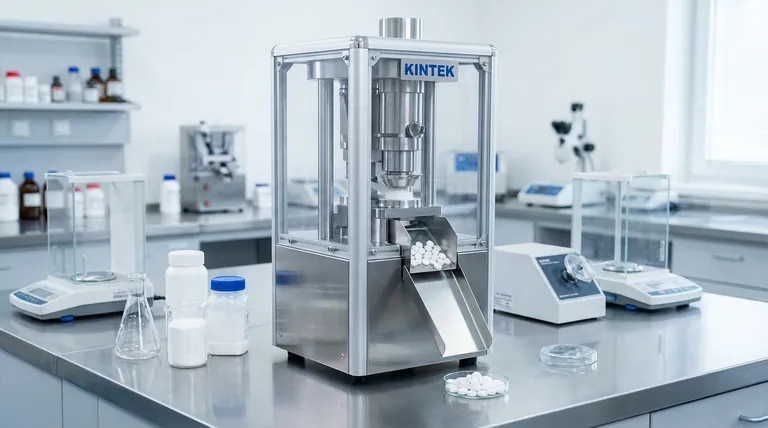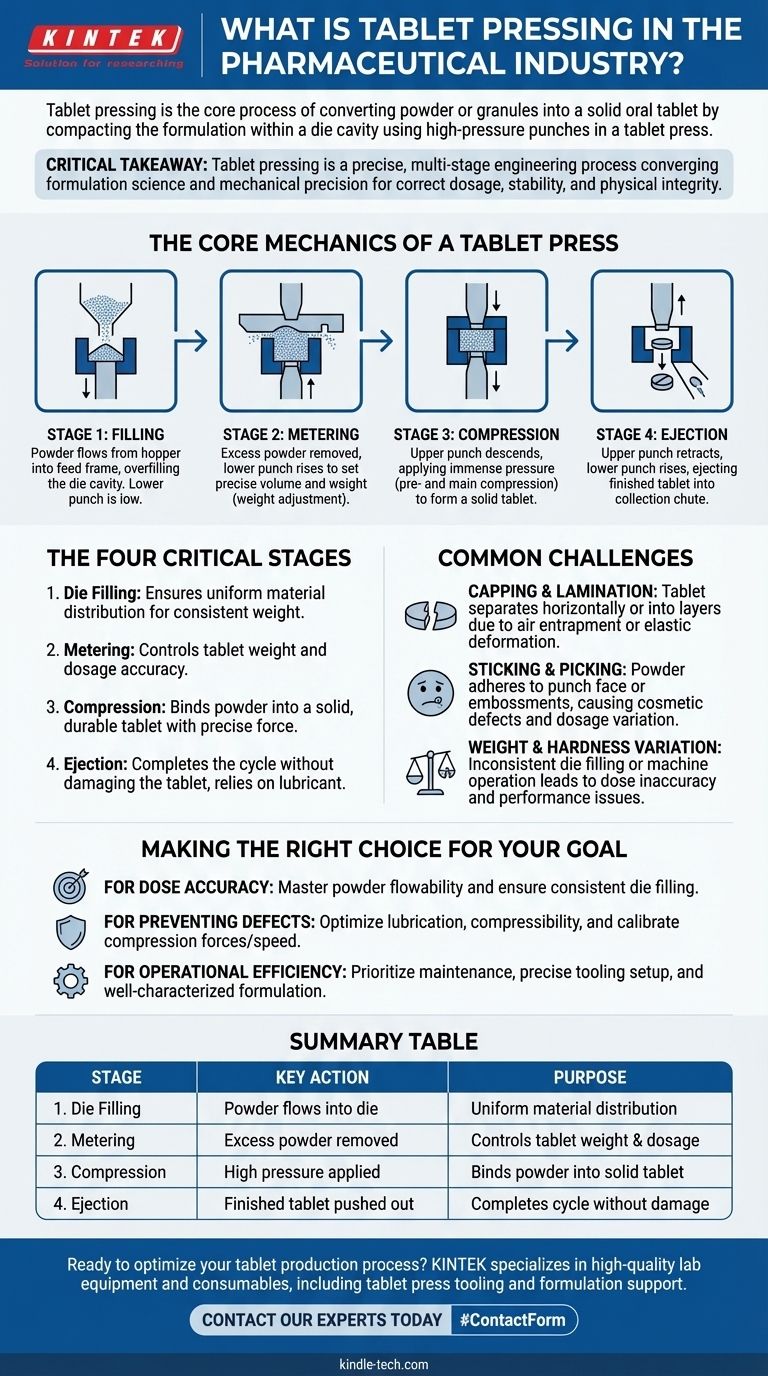가장 간단하게 말해, 타정은 제약 산업에서 분말 또는 과립 형태의 약물 제형을 정제라고 불리는 고체 경구용 제형으로 변환하는 핵심 제조 공정입니다. 이는 타정기(tablet press)라는 기계 내부에서 두 개의 고압 펀치를 사용하여 다이 캐비티 내에서 제형을 압축함으로써 달성됩니다.
핵심은 타정은 단순한 압축이 아니라는 점입니다. 이는 제형 과학과 기계적 정밀도가 융합되어 모든 단일 정제가 안전하고 효과적인 의약품에 필요한 정확한 용량, 안정성 및 물리적 무결성을 갖도록 보장하는 정밀한 다단계 엔지니어링 프로세스입니다.
타정기의 핵심 메커니즘
타정 공정을 이해하려면 먼저 이를 가능하게 하는 기계를 이해해야 합니다. 이 공정은 완벽하게 동기화되어 작동하는 몇 가지 핵심 구성 요소를 중심으로 이루어집니다.
핵심 요소: 펀치와 다이
모든 타정기의 핵심은 툴링(tooling)입니다. 이는 상부 펀치, 하부 펀치 및 다이 세트입니다. 다이(die)는 정제의 모양과 직경을 정의하는 정밀하게 가공된 캐비티입니다.
하부 펀치는 다이 캐비티의 바닥을 형성하며, 상부 펀치는 하강하여 주요 압축력을 가합니다.
충전 단계
공정은 종종 과립 형태인 제형화된 분말이 호퍼(hopper)에 담겨 있는 것에서 시작됩니다. 이 물질은 피드 프레임(feed frame)으로 흘러 들어가 다이 테이블 위로 분말을 분배합니다.
다이가 피드 프레임 아래를 통과할 때 하부 펀치는 낮은 위치에 있어 다이 캐비티가 분말로 과도하게 채워지도록 합니다.
압축 단계
채워진 후, 하부 펀치는 특정 높이까지 상승하여 과도한 분말을 밀어내어 다이 내부에 정확하고 반복 가능한 부피, 즉 무게를 보장합니다. 이를 계량(metering) 또는 무게 조정(weight adjustment)이라고 합니다.
그런 다음 상부 펀치가 다이 안으로 내려오고, 두 펀치 모두 엄청나고 제어된 압력을 가하는 대형 롤러 사이를 통과합니다. 이 힘은 분말 입자를 압축하여 서로 결합시켜 단단한 정제를 형성합니다. 많은 최신 타정기는 2단계 압축을 사용합니다. 공기를 제거하기 위한 가벼운 예비 압축(pre-compression) 후 주 압축(main compression)이 이어집니다.
배출 단계
주 압축 후 상부 펀치가 후퇴합니다. 그런 다음 하부 펀치가 상승하여 완성된 정제를 다이 위로 밀어 올려 수집 슈트로 쓸어냅니다. 이 사이클은 최신 회전식 타정기에서 분당 수천 번 반복됩니다.

분말에서 알약까지: 네 가지 중요한 단계
메커니즘에는 펀치와 다이가 포함되지만, 공정 자체는 완벽하게 제어되어야 하는 네 가지 뚜렷하고 중요한 단계로 나눌 수 있습니다.
1. 다이 충전
이것이 기초 단계입니다. 분말 제형은 호퍼에서 다이 캐비티로 균일하고 일관되게 흘러야 합니다. 불일치한 흐름은 정제 무게 변동의 주요 원인입니다.
2. 계량(무게 조정)
다이가 과도하게 채워진 후 스크레이퍼 블레이드가 과도한 분말을 제거합니다. 이 단계에서 하부 펀치의 높이는 다이에 남아 있는 분말의 부피를 제어하도록 정밀하게 설정되며, 이는 정제의 무게와 용량을 직접적으로 결정합니다.
3. 압축
이것이 정제가 형성되는 곳입니다. 펀치에 가해지는 힘은 단단하고 내구성 있는 정제를 만들기에 충분해야 하지만, 박리(lamination)나 캡핑(capping)과 같은 결함을 유발할 정도로 높아서는 안 됩니다. 이 힘은 중요한 공정 매개변수입니다.
4. 배출
최종 정제는 깨지거나 부서지지 않고 다이에서 깨끗하게 밀려 나와야 합니다. 이는 적절한 프레스 설정과 결정적으로 분말 제형 내의 적절한 양의 윤활제에 달려 있습니다.
상충 관계 및 일반적인 과제 이해하기
타정은 과학이지만 제품 품질을 손상시킬 수 있는 일반적인 제조 과제에 직면합니다. 이러한 과제를 이해하는 것이 문제 해결의 열쇠입니다.
캡핑 및 박리
캡핑(Capping)은 정제 상단이 수평으로 분리되는 것이고, 박리(Lamination)는 정제가 두 개 이상의 뚜렷한 층으로 분리되는 것입니다. 이는 종종 압축 중에 분말에 공기가 갇히거나 제형이 결합되는 대신 탄성적으로 변형되기 때문에 발생합니다.
들러붙음 및 픽킹
들러붙음(Sticking)은 분말 제형이 펀치의 평평한 면에 달라붙을 때 발생합니다. 픽킹(Picking)은 펀치 표면에 엠보싱된 로고나 문자의 작은 세부 사항에 물질이 달라붙는 보다 구체적인 버전입니다. 둘 다 외관상 보기 좋지 않은 정제를 초래하며 용량 균일성에 영향을 미칠 수 있습니다. 이는 일반적으로 제형 내의 부적절한 윤활 또는 수분 문제의 징후입니다.
무게 및 경도 변동
모든 정제가 동일한 무게와 경도를 갖도록 보장하는 것은 용량 정확성과 성능을 위해 타협할 수 없는 사항입니다. 변동은 종종 다이로의 분말 유동성(flowability) 불량 또는 기계 작동의 불일치에서 비롯됩니다. 너무 부드러운 정제는 부서질 수 있고, 너무 단단한 정제는 체내에서 제대로 용해되지 않을 수 있습니다.
목표에 맞는 올바른 선택하기
타정 공정을 최적화하려면 제형, 기계 설정 및 원하는 결과를 균형 있게 조정해야 합니다.
- 용량 정확성이 주요 초점인 경우: 분말 유동성을 마스터하고 일관되고 균일한 다이 충전을 보장합니다. 이것이 무게 제어의 기초입니다.
- 물리적 결함 방지가 주요 초점인 경우: 제형의 윤활 및 압축성을 주의 깊게 살펴보고 압축력과 프레스 속도를 신중하게 보정합니다.
- 운영 효율성이 주요 초점인 경우: 정기적인 기계 유지 보수, 정확한 툴링 설정 및 원활하게 작동하는 것으로 알려진 잘 특성화된 제형을 우선시합니다.
타정 원리를 숙달하는 것은 안전하고 효과적인 경구용 고형 의약품의 일관되고 신뢰할 수 있는 생산에 필수적입니다.
요약표:
| 단계 | 주요 조치 | 목적 |
|---|---|---|
| 1. 다이 충전 | 분말이 다이 캐비티로 흐름 | 균일한 재료 분배 보장 |
| 2. 계량 | 과도한 분말 제거; 하부 펀치 높이 조정 | 정제 무게 및 용량 정확도 제어 |
| 3. 압축 | 상부 및 하부 펀치가 고압을 가함 | 분말을 단단하고 내구성 있는 정제로 결합 |
| 4. 배출 | 완성된 정제가 다이에서 밀려 나옴 | 정제를 손상시키지 않고 사이클 완료 |
타정 생산 공정 최적화를 준비하셨습니까? KINTEK은 제약 제조를 위한 고품질 실험실 장비 및 소모품을 전문으로 합니다. 타정 툴링 및 제형 지원에 대한 당사의 전문 지식은 일관된 용량을 달성하고, 캡핑 및 들러붙음과 같은 결함을 방지하며, 운영 효율성을 개선하는 데 도움이 될 수 있습니다. 귀하의 실험실의 특정 타정 요구 사항을 지원하는 방법에 대해 논의하려면 오늘 전문가에게 문의하십시오.
시각적 가이드

관련 제품
- 단일 펀치 전기 타블렛 프레스 기계 실험실 분말 타블렛 펀칭 TDP 타블렛 프레스
- 실험실 규모 회전 단일 펀치 타블렛 프레스 기계 TDP 타블렛 펀칭 기계
- TDP용 단일 펀치 타블렛 프레스 기계 및 대량 생산 회전식 타블렛 펀칭 기계
- 회전 타원형 및 정사각형 몰드를 위한 멀티 펀치 로터리 타블렛 프레스 몰드 링
- 고압 적용을 위한 온간 등압 성형기 WIP 워크스테이션 300Mpa



















